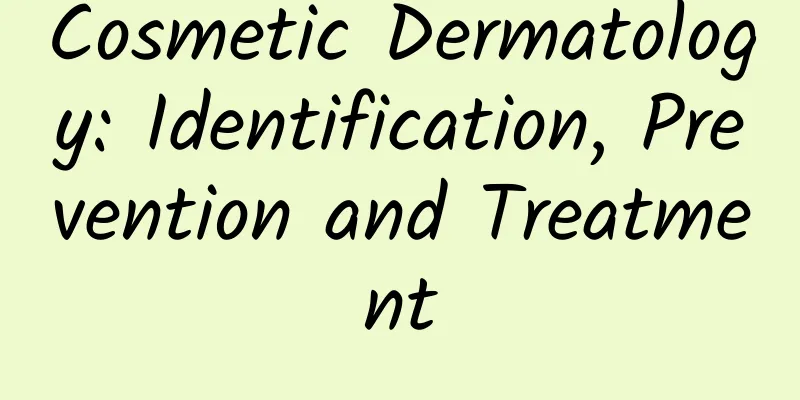Cosmetic Dermatology: Identification, Prevention and Treatment

|
Author: Wu Yan, Chief Physician, Peking University First Hospital Reviewer: He Yanling, Chief Physician, Beijing Chaoyang Hospital, Capital Medical University Cosmetic dermatitis refers to diseases of the skin and its appendages caused by cosmetics. There are many types, including but not limited to contact dermatitis, acne, pigmentation, etc. Among them, contact dermatitis is particularly common. After using certain cosmetics, symptoms such as redness, itching, papules and even blisters may quickly appear on the local skin. Taking hair dye allergy as an example, paraphenylenediamine in hair dye is a common ingredient that causes contact dermatitis. After using hair dye containing paraphenylenediamine, some patients will not only have allergic reactions on their scalp, but as the hair dye spreads, their face, neck and even chest and back may also be affected. Contact dermatitis usually occurs within hours to days after contact with cosmetics, and once it occurs, the relevant products should be discontinued immediately and medical treatment should be sought. In addition to contact dermatitis, cosmetics may also cause skin problems such as acne and pigmentation. For acne-prone skin, avoid using products containing closed oil ingredients such as petrolatum, as they can easily clog pores and aggravate acne. In addition, the mineral oil ingredients in makeup removers may also cause pores to clog, so acne-prone skin should be used with caution. Makeup products, especially liquid foundation, may also cause pores to clog because they are not easily soluble in water and often mix with oils, so products labeled "non-comedogenic" should be selected. Figure 1 Original copyright image, no permission to reprint When choosing cosmetics, patients need to pay attention to the product's ingredient list and avoid known irritants. It is recommended to give priority to oil-free formulas, low comedogenicity, and non-allergenic products. In addition, regular cleaning of makeup tools, such as brushes and sponges, can also help reduce bacterial growth and reduce the risk of acne. In order to prevent cosmetic skin diseases, it is essential to scientifically select and use cosmetics reasonably. First, when purchasing cosmetics, consumers should carefully check the product ingredient list and avoid using products containing ingredients that they are known to be allergic to. For ingredients that you are not sure whether you are allergic to, you can perform a simple skin test, such as applying a small amount of the product behind the ear or on the inside of the arm to observe whether there is an adverse reaction. Figure 2 Original copyright image, no permission to reprint Secondly, people with different skin types should choose cosmetics that are suitable for their skin types. For example, oily skin should choose products with good oil control effects, while dry skin should focus on moisturizing. In addition, during the process of applying and removing makeup, care should be taken to avoid excessive friction and squeezing of the skin to avoid skin damage. For those who often need to dye their hair, it is recommended to choose hair dyes that do not contain allergenic ingredients such as p-phenylenediamine, and to perform a patch test before dyeing to determine whether there is an allergy. During the hair dyeing process, the contact time between the hair dye and the skin should be minimized, and the hair and other parts of the body should be washed promptly after dyeing to reduce the irritation of the residual hair dye on the skin. Once a cosmetic skin disease is diagnosed, the first thing to do is to stop using the suspected cosmetics immediately and seek medical treatment. Depending on the condition, the doctor may develop a personalized treatment plan, including oral antihistamines, topical anti-inflammatory drugs, and physical therapy. During the treatment process, the patient should actively cooperate with the doctor's treatment recommendations, take and apply the medicine on time, and pay attention to changes in the condition. For skin barrier damage caused by cosmetics, patients should focus on skin moisturizing and repairing during treatment. Mild and non-irritating moisturizing products, such as those containing hyaluronic acid, glycerin and other moisturizing ingredients, can be selected to help the skin restore water-oil balance and barrier function. In addition, attention should be paid to balanced nutrition in diet, and more foods rich in vitamins and minerals should be consumed to promote skin repair and regeneration. It is worth noting that the treatment of cosmetic dermatitis is a comprehensive process that requires not only the professional guidance of doctors and the implementation of treatment plans, but also the active cooperation and care of patients themselves. Through scientific prevention and reasonable treatment, we can effectively reduce the incidence of cosmetic dermatitis and promote the maintenance and recovery of skin health. |
<<: Skin care tips: cosmetic selection and application tips for sensitive skin
>>: Beauty without worries: Dealing with allergies, choosing makeup and men's skin care
Recommend
Can I eat squid during menstruation?
Most women know that menstruation is very painful...
Pregnant woman has stomach pain at night
When a female friend becomes a pregnant woman, ma...
Left breast hypoechoic nodule type 3
Most women have experienced breast and other rela...
Is the duct air conditioner effective? What are the advantages and disadvantages of central air conditioners and duct air conditioners?
Duct air conditioner is a new type of air conditi...
Gestational sac, fetal bud, fetal heart rate comparison table
Pregnant friends can use B-ultrasound to check wh...
A complete collection of spring soup recipes, worth collecting!
Everything comes back to life in spring, and ther...
Pregnancy skin treatments
Dry skin during pregnancy has greatly reduced the...
Possible causes of stringy leucorrhea during menstruation
It is not known why more and more women are facin...
Still bleeding two weeks after abortion
After a medical abortion, you should take good ca...
Can I eat donkey-hide gelatin cake during breastfeeding?
Women will eat a lot of nutritional supplements d...
Is it normal to have no stringy leucorrhea?
We all know that leucorrhea will appear stringy a...
How to scientifically manage confinement
Confinement is the primary task for mothers after...
Causes of recurrent bacterial vaginosis
Most married women often suffer from vaginitis. T...
Are you still a zebra girl?
First paragraph: Pigmentation is a type of facial...
How to remedy sexual intercourse during menstruation
It is common sense in sexual life that you cannot...









